Liver Cancer Therapeutics Market Size
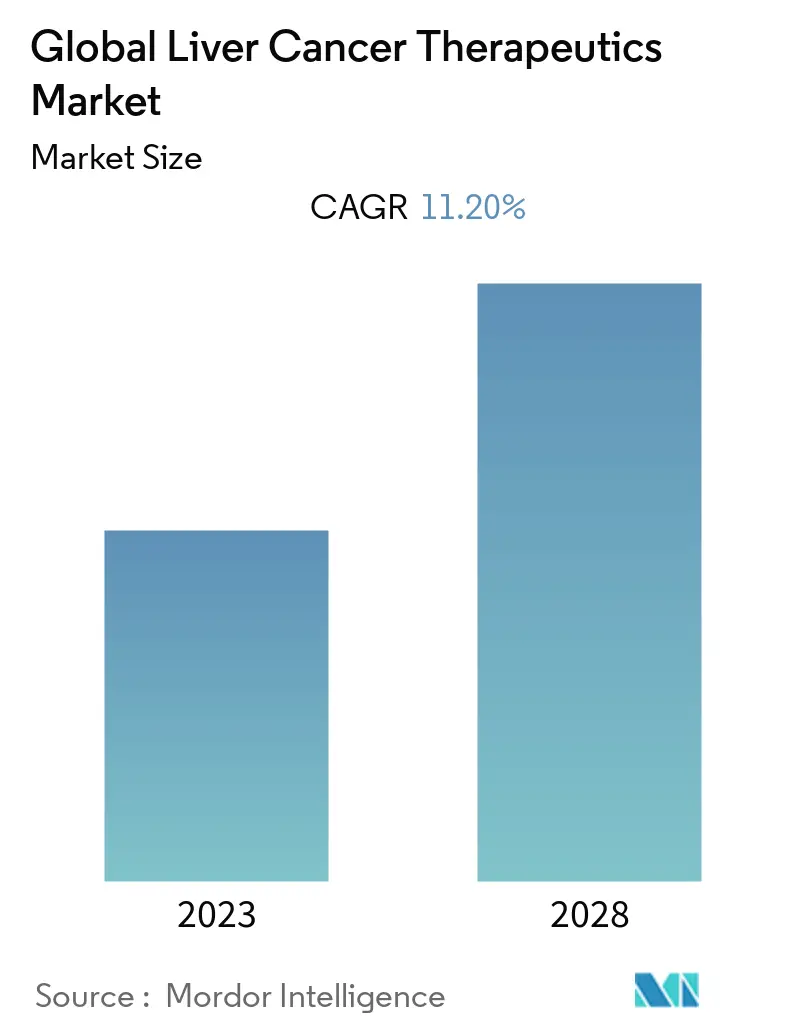
| Study Period | 2018 - 2028 |
| Base Year For Estimation | 2021 |
| CAGR | 11.20 % |
| Fastest Growing Market | Asia Pacific |
| Largest Market | North America |
| Market Concentration | High |
Major Players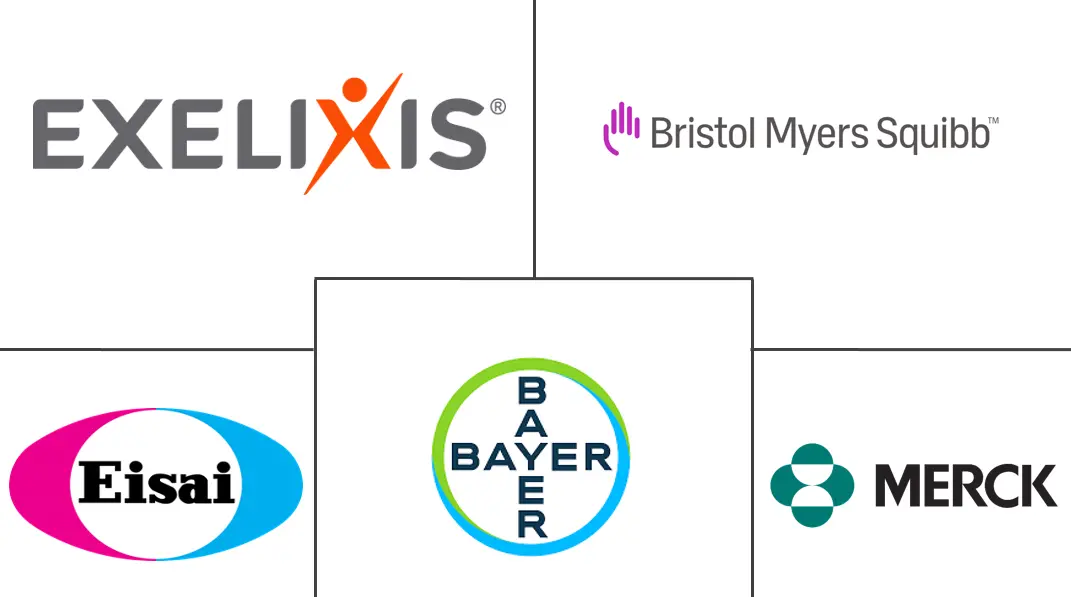
*Disclaimer: Major Players sorted in no particular order |
Need a report that reflects how COVID-19 has impacted this market and its growth?
Liver Cancer Therapeutics Market Analysis
The liver cancer therapeutics market is anticipated to grow at a CAGR of 11.2% over the forecast period (2022-2027).
The emergence of COVID-19 had a major impact on patients other than COVID-19 due to the high burden on the healthcare resources owing to the high infection rate of the SARS-CoV-2 virus. The people with liver cancer were also impacted by the pandemic as due to COVID-19, there was delay or rescheduling of the diagnostics and treatment procedures, and also as people with comorbidity were at higher risk of contracting COVID-19 which led to the decline in footfall in hospitals for treatment and diagnostics of new cases. For instance, according to a research study titled “Assessing the impact of COVID-19 on liver cancer management (CERO-19)”, published in February 2021, the normal treatment of patients with liver cancer was significantly impacted by the first wave of the COVID-19 epidemic and changes to the algorithms for screening, diagnosing, and treating patients may have materially harmed their prognosis during the pandemic. However, with the decreasing COVID-19 cases and large-scale vaccination programs, the liver cancer therapeutics market is expected to gain its full growth potential over the forecast period.
The major factors driving the market growth include the rising burden of liver cancer, increasing research and development investments for the development of novel therapies, and government initiatives to increase cancer awareness. For instance, according to the Globocan 2020 report, about 905,677 new cases of liver cancer were diagnosed in 2020, globally and this number to projected to reach 1.16 million by 2030 and will continue to increase. Hence, the demand for effective and advanced liver cancer therapeutics is expected to increase over the years, fuelling growth in the studied market. The change in the current lifestyle led to the exposure of a large population to certain risk factors that contribute to liver cancer. The risk factors include type 2 diabetes, hepatitis, metabolic disorders, excess body weight, alcohol consumption, and smoking which are further expected to augment the liver cancer therapeutics market’s growth over the forecast period.
Moreover, the increasing research activities and funding in the area are further expected to boost the market’s growth as a positive outcome from these studies may pave the way for a novel treatment for liver cancer. For example, according to National Clinical Trial (NCT) Registry 2020, Hoffmann-La Roche Ltd started a phase Ib/II study to assess the efficacy and safety of multiple immunotherapy-based treatment combinations in patients with advanced liver cancers (Morpheus-Liver). The trial started in November 2020 and is expected to be completed in July 2024. Further, a researcher from Edith Cowan University (ECU), Australia, received USD 2.35 million in funding to support a new form of radiotherapy treatment for liver cancer to be trialed in locations across Australia over the next five years. Therefore, owing to the high burden of liver cancer and its risk factors coupled with ongoing research and development activities is expected to boost the market’s growth over the forecast period. However, factors such as side effects associated with certain medications and the high cost of cancer therapies, and stringent regulatory scenarios, are expected to impede market growth over the forecast period.
Liver Cancer Therapeutics Market Trends
This section covers the major market trends shaping the Liver Cancer Therapeutics Market according to our research experts:
Hepatocellular Carcinoma Segment is Expected to Occupy a Significant Share Over the Forecast Period
Hepatocellular carcinoma (HCC) is a common form of liver cancer that occurs in people suffering from chronic liver diseases like cirrhosis. Globally, it is one of the major causes leading to cancer-related deaths.
Pharmaceutical companies adopted various strategies to maintain the balance between the supply and demand of liver cancer therapeutics. Health organizations have issued necessary guidelines and recommendations for managing hepatocellular carcinoma patients during the COVID-19 pandemic. For instance, the European Society of Medical Oncology (ESMO), the American Society of Clinical Oncology (ASCO), and the National Institute of Health and Care Excellence (NICE) have proposed guidelines. The guidelines include that during the COVID-19 pandemic 2020, patients with chronic liver disease, such as hepatocellular carcinoma (HCC) and COVID-19, were recommended to admit for inpatient care as per the European Society for Medical Oncology, which shows the positive impact on the market.
Furthermore, several research studies confirmed that patients with hepatocellular carcinoma are at a higher risk of contracting the infection. According to a research study by Giuliana Amadeo et al., published in JHEP Reports Journal 2021, a study was conducted in 6 referral centers in the metropolitan area of Paris, France, to assess the impact of the COVID-19 pandemic on the management of patients with hepatocellular carcinoma (HCC). The study results found that in a metropolitan area of Paris, hepatocellular carcinoma (HCC) patients were highly impacted by the COVID-19 pandemic, and there was a significantly longer treatment delay in 2020 compared to 2019. This indicates that during the COVID-19 pandemic 2020, the treatment for hepatocellular carcinoma (HCC) patients was delayed as healthcare resources were occupied with providing services to COVID-19 patients, which showed a short-term negative impact on segment growth.
According to a research article by Eunsun Kim et al., published in Experimental & Molecular Medicine Journal 2020, stated that globally, hepatocellular carcinoma (HCC) accounts for 90% of primary liver cancer, which is the fourth most common cause of cancer-related deaths. The incidence rate associated with non-alcoholic fatty liver disease (NAFLD) and non-alcoholic steatohepatitis (NASH) is increasing, and the global burden of mortality from hepatocellular carcinoma (HCC) is predicted to reach 1 million deaths annually by 2030. It is asymptomatic in its early stage, which significantly delays its timely diagnosis.
It is observed that the Asian and African countries have higher incidence rates of hepatocellular carcinoma than the developed world due to the disparity in the major risk factors causing hepatocellular carcinoma, such as hepatitis B (HBV) and hepatitis C virus (HCV) infection in those regions.
The increasing burden of hepatocellular carcinoma is expected to increase a huge demand for liver cancer therapeutics. In November 2020, Zymeworks Inc. received the United States Food and Drug Administration (FDA) breakthrough therapy designation for zanidatamab in patients with previously treated HER2 gene-amplified biliary tract cancer (BTC). Hence, the rising incidence of cancer and high unmet medical needs are the major factors that drive the segment growth over the forecast period.
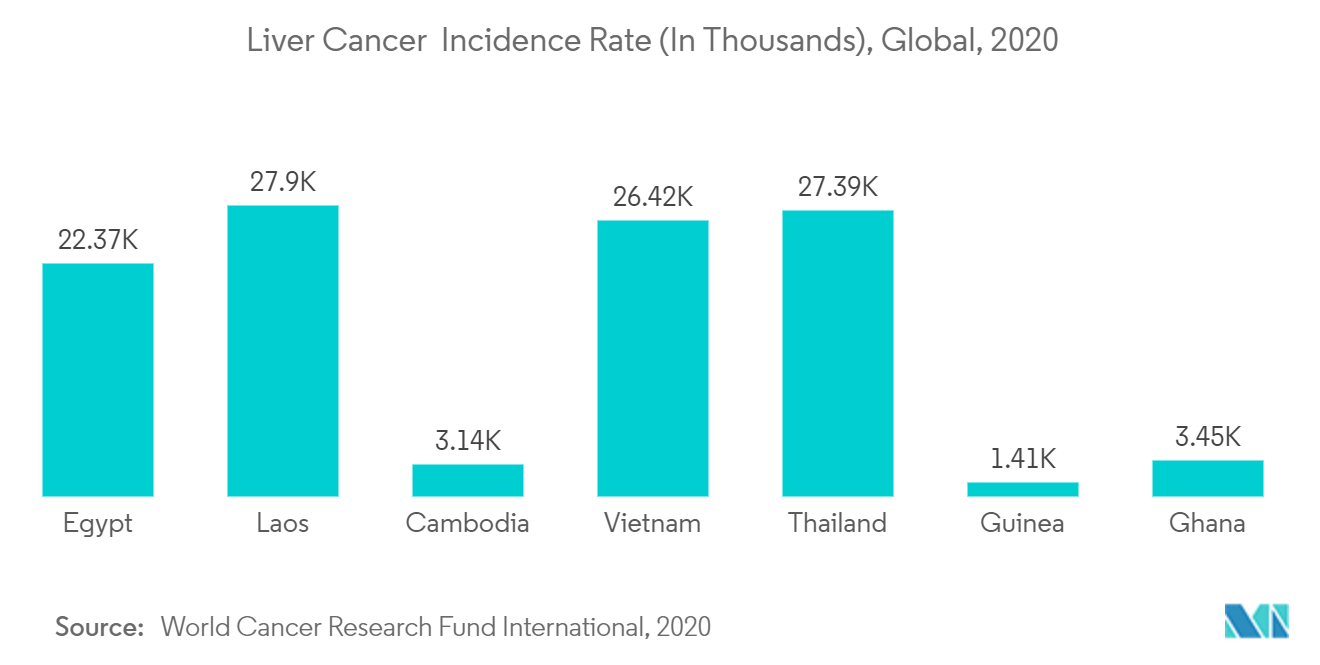
North America is Expected to Dominate the Liver Cancer Therapeutics Market
The major factors driving the market growth in North America include the rising incidence of liver cancer in the region, the presence of key market players, and the launch of novel products, which will influence growth in the region.
As per the Centers for Disease Control and Prevention (CDC), the geriatric population that includes patients with serious underlying medical conditions, including people with liver disease, might be at higher risk for severe illness from COVID-19. Patients with hepatocellular carcinoma (HCC), which occurs most often in people with chronic liver diseases, such as hepatitis B or hepatitis C, are at higher risk for severe COVID-19 than those without hepatocellular carcinoma.
The high burden of liver cancer in the region is expected to be the primary market driving factor with the increase in liver cancer burden and awareness about it, the adoption and demand of treatment procedures is increased which is expected to have a positive impact on the studied market, for instance, according to the 2022 report of the American Cancer Society, about 41,260 new cases of liver and intrahepatic bile duct cancer are expected to be diagnosed in the United States in 2022 which is expected to have a positive impact on the liver cancer therapeutics market.
Further, in the United States, the increasing research and development activities in the development of novel therapeutics for the liver are also expected to drive market growth. For instance, in May 2020, the Food and Drug Administration (FDA) approved atezolizumab (Tecentriq) and bevacizumab (Avastin) as an initial treatment for people with liver cancer that spread or that can’t be treated with surgery. Similarly, in November 2020, Exelixis Inc. received the United States Food and Drug Administration (FDA) approval for CABOMETYX for the treatment of unresectable hepatocellular carcinoma.
Therefore, the increased incidence of liver cancer in the United States with the rising demand for liver cancer treatment is driving the market over the forecast period.
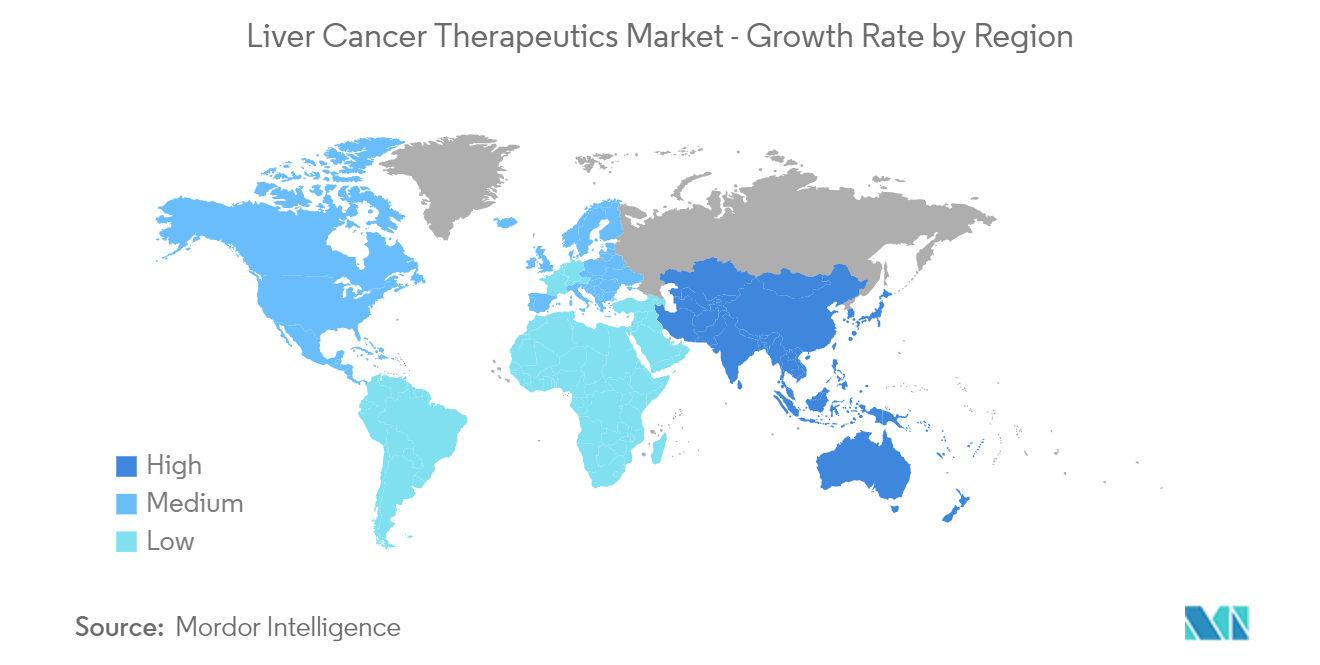
Liver Cancer Therapeutics Industry Overview
The liver cancer therapeutics market studied is a consolidated competitive, owing to the presence of a few major market players. The key market players are focusing on R&D to bring innovative treatments for the treatment of liver cancer. The key market players are F. Hoffmann-La Roche Ltd, Bayer AG, Bristol Myers Squibb Company, Celsion Corporation, Eisai Co. Ltd, Exelixis Inc., Eli Lilly and Company, Merck & Co. Inc., Pfizer Inc., AbbVie Inc., Amgen Inc., AstraZeneca PLC, Johnson & Johnson, Sanofi SA, and Novartis AG.
Liver Cancer Therapeutics Market Leaders
Bristol‑Myers Squibb Company
Eisai Co., Ltd.
Exelixis Inc
Merck & Co. Inc.
Bayer AG
*Disclaimer: Major Players sorted in no particular order
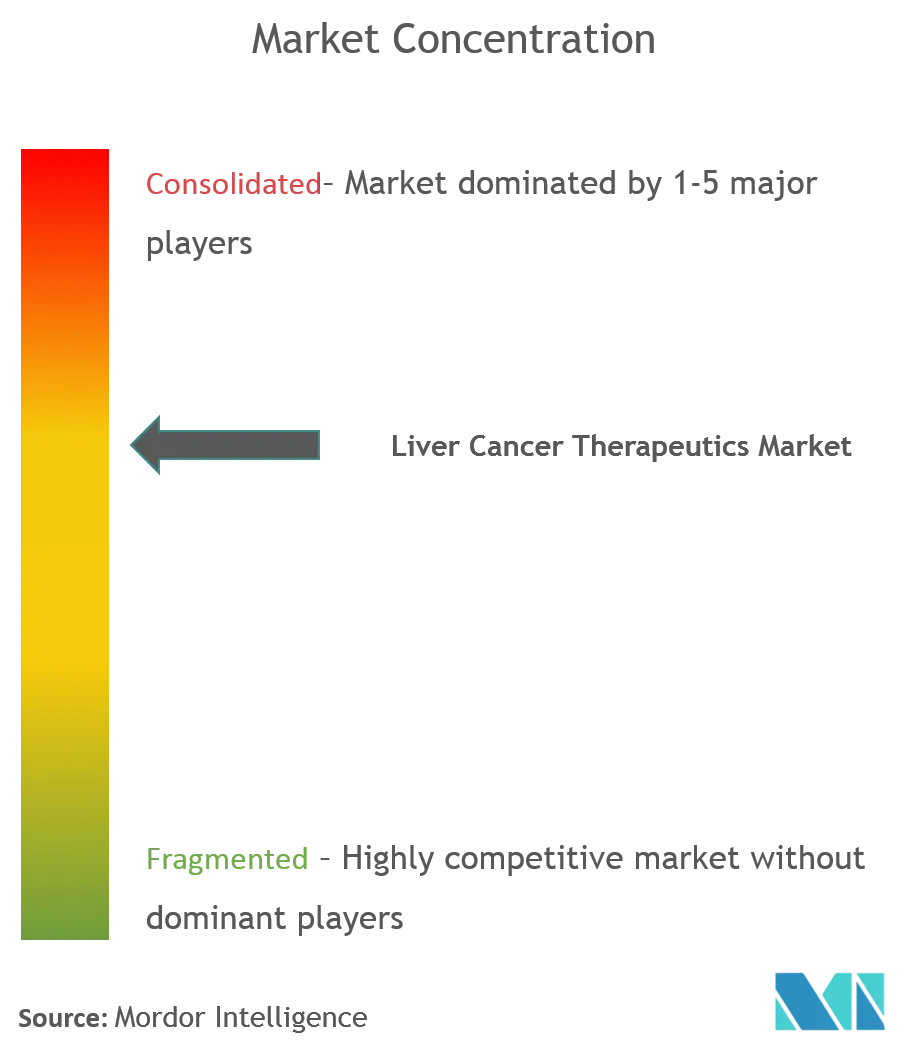
Liver Cancer Therapeutics Market News
- In January 2022, Merck received conditional liver cancer treatment approval for its drug Keytruda on the basis of its second confirmatory study. Keytruda slashed the risk of death by 21% over placebo in hepatocellular carcinoma patients in Asia.
- In March 2021, Boston Scientific Corporation received United States Food and Drug Administration (FDA) approval for the TheraSphere Y-90 Glass Microspheres, developed for the treatment of patients with hepatocellular carcinoma (HCC).
Liver Cancer Therapeutics Market Report - Table of Contents
1. INTRODUCTION
1.1 Study Assumptions and Market Definitions
1.2 Scope of the Study
2. RESEARCH METHODOLOGY
3. EXECUTIVE SUMMARY
4. MARKET DYNAMICS
4.1 Market Overview
4.2 Market Drivers
4.2.1 Rising Burden of Liver Cancer
4.2.2 Increasing R&D Investments for the Development of Novel Therapies
4.2.3 Government Initiatives to Increase the Cancer Awareness
4.3 Market Restraints
4.3.1 Side Effects Associated with Certain Medications Coupled with High Cost of Cancer Therapies
4.3.2 Stringent Regulatory Scenario
4.4 Porter's Five Force Analysis
4.4.1 Threat of New Entrants
4.4.2 Bargaining Power of Buyers/Consumers
4.4.3 Bargaining Power of Suppliers
4.4.4 Threat of Substitute Products
4.4.5 Intensity of Competitive Rivalry
5. MARKET SEGMENTATION (Market Size by Value – USD million)
5.1 By Type
5.1.1 Hepatocellular Carcinoma
5.1.2 Cholangio Carcinoma
5.1.3 Hepatoblastoma
5.1.4 Other Types
5.2 By Therapy
5.2.1 Targeted Therapy
5.2.2 Radiation Therapy
5.2.3 Immunotherapy
5.2.4 Chemotherapy
5.3 Geography
5.3.1 North America
5.3.1.1 United States
5.3.1.2 Canada
5.3.1.3 Mexico
5.3.2 Europe
5.3.2.1 Germany
5.3.2.2 United Kingdom
5.3.2.3 France
5.3.2.4 Italy
5.3.2.5 Spain
5.3.2.6 Rest of Europe
5.3.3 Asia-Pacific
5.3.3.1 China
5.3.3.2 Japan
5.3.3.3 India
5.3.3.4 Australia
5.3.3.5 South Korea
5.3.3.6 Rest of Asia-Pacific
5.3.4 Middle East and Africa
5.3.4.1 GCC
5.3.4.2 South Africa
5.3.4.3 Rest of Middle East and Africa
5.3.5 South America
5.3.5.1 Brazil
5.3.5.2 Argentina
5.3.5.3 Rest of South America
6. COMPETITIVE LANDSCAPE
6.1 Company Profiles
6.1.1 F. Hoffmann-La Roche Ltd
6.1.2 Bayer AG
6.1.3 Bristol Myers Squibb Company
6.1.4 Celsion Corporation
6.1.5 Eisai Co. Ltd
6.1.6 Exelixis Inc.
6.1.7 Eli Lilly and Company
6.1.8 Merck & Co. Inc.
6.1.9 Pfizer Inc.
6.1.10 AbbVie Inc.
6.1.11 Amgen Inc.
6.1.12 AstraZeneca PLC
6.1.13 Johnson & Johnson
6.1.14 Sanofi SA
6.1.15 Novartis AG
- *List Not Exhaustive
7. MARKET OPPORTUNITIES AND FUTURE TRENDS
Liver Cancer Therapeutics Industry Segmentation
As per the scope of the report, liver cancer is cancer that begins in the liver cells. It is a chronic, life-threatening, and progressive disorder that begins in the cells of the liver. Liver cancer can be of different types, such as cancer that begins in hepatocyte cells, known as primary hepatic cancer, and cancer that spreads to the liver from other parts of the body, known as metastatic cancer. The global liver cancer therapeutics market is segmented by type (hepatocellular carcinoma, cholangiocarcinoma, hepatoblastoma, and other types), therapy (targeted therapy, radiation therapy, immunotherapy, and chemotherapy), and geography (North America, Europe, Asia-Pacific, the Middle-East and Africa, and South America). The market report also covers the estimated market sizes and trends for 17 different countries across major regions globally. The report offers the value (USD million) for the above-mentioned segments.
| By Type | |
| Hepatocellular Carcinoma | |
| Cholangio Carcinoma | |
| Hepatoblastoma | |
| Other Types |
| By Therapy | |
| Targeted Therapy | |
| Radiation Therapy | |
| Immunotherapy | |
| Chemotherapy |
| Geography | ||||||||
| ||||||||
| ||||||||
| ||||||||
| ||||||||
|
Liver Cancer Therapeutics Market Research FAQs
What is the current Global Liver Cancer Therapeutics Market size?
The Global Liver Cancer Therapeutics Market is projected to register a CAGR of 11.2% during the forecast period (2023-2028).
Who are the key players in Global Liver Cancer Therapeutics Market?
Bristol‑Myers Squibb Company, Eisai Co., Ltd., Exelixis Inc, Merck & Co. Inc. and Bayer AG are the major companies operating in the Global Liver Cancer Therapeutics Market.
Which is the fastest growing region in Global Liver Cancer Therapeutics Market?
Asia Pacific is estimated to grow at the highest CAGR over the forecast period (2023-2028).
Which region has the biggest share in Global Liver Cancer Therapeutics Market?
In 2023, the North America accounts for the largest market share in the Global Liver Cancer Therapeutics Market.
Global Liver Cancer Therapeutics Industry Report
Statistics for the 2023 Global Liver Cancer Therapeutics market share, size and revenue growth rate, created by Mordor Intelligence™ Industry Reports. Global Liver Cancer Therapeutics analysis includes a market forecast outlook to 2028 and historical overview. Get a sample of this industry analysis as a free report PDF download.
